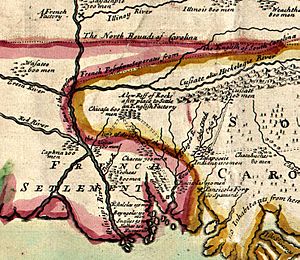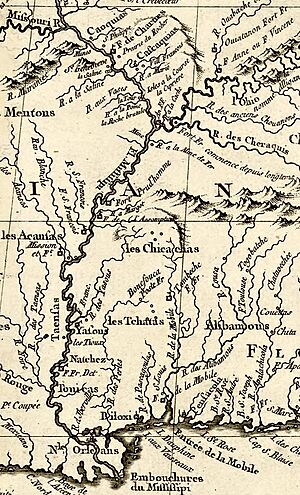Chickasaw Wars facts for kids
Quick facts for kids Chickasaw Wars |
|||||||
|---|---|---|---|---|---|---|---|
| Part of the American Indian Wars | |||||||
 1711 map well illustrating the position of British-aligned Chickasaws on the French Mississippi. |
|||||||
|
|||||||
| Belligerents | |||||||
Chickasaw |
Choctaw Illini |
||||||
The Chickasaw Wars were a series of fights in the 1700s. They happened between the Chickasaw people, who were friends with the British, and the French along with their allies, the Choctaw and Illini. The French wanted to control the Mississippi River for trade and travel. The Chickasaw lived right in the way, in what is now northern Mississippi and western Tennessee.
The Chickasaw successfully defended their land. This was a big win for them and later helped the British and the United States. The wars finally ended in 1763. This was when France gave up its lands in North America to the British, as part of the Treaty of Paris.
Contents
Early Conflicts and Choctaw Raids
Jean-Baptiste Le Moyne de Bienville, who founded New Orleans and was the governor of Louisiana, wanted to stop the Chickasaw from trading with the British. In 1721, he convinced the Choctaw to start attacking Chickasaw villages. They also ambushed groups carrying goods along the Trader's Path to Charleston, South Carolina.
To protect themselves, the Chickasaw moved their villages closer together. They also made their friendship with the British stronger. They even set up a settlement at Savannah Town, South Carolina, in 1723, to get more guns. The Chickasaw also blocked French boats on the Mississippi River from a place called Chickasaw Bluff, near modern-day Memphis. They tried to make peace with the Choctaw. Bienville was called back to France in 1724.
Over the next few years, the French kept stirring up trouble between the Native American groups. The Choctaw used "hit and run" attacks. They would ambush hunting parties, kill horses, and destroy crops. They often used their larger numbers to force the Chickasaw into their forts. They even killed messengers trying to make peace. Sometimes, the Illini and Iroquois from the north also joined in the attacks.
This constant fighting slowly wore down the Chickasaw. Things got very difficult for them in the late 1730s and early 1740s. After a break due to problems within the Choctaw, the attacks started again in the 1750s. Despite this, the Chickasaw remained strong. Their tough situation made them rely even more on their British allies.
In 1734, Bienville returned to Louisiana. He planned big military campaigns against the Chickasaw, using European battle styles.
The Big French Attacks
The 1736 Attack
Bienville gathered a large army in Mobile. He led them up the Tombigbee River from Fort Tombecbe. His plan was to meet another French force coming from the north. This northern force was led by Pierre D'Artaguiette and included French soldiers and their Illini allies, led by Chief Chicagou.
On March 25, 1736, the northern force attacked a Chickasaw village called Ogoula Tchetoka. This village was near what is now northwest Tupelo, Mississippi. The French and their allies were badly defeated, and d'Artaguiette was killed.
Bienville did not know about this disaster. On May 26, 1736, he and his army of 1,200 French and Choctaw soldiers attacked the fortified Chickasaw village of Ackia. This village was in present-day south Tupelo. Bienville's army was pushed back. He returned to Mobile and New Orleans, having failed in his mission.
The 1739 Plan
Bienville was told to try again. This time, he brought heavy equipment for attacking forts. He gathered his forces at Fort Assumption on the Fourth Chickasaw Bluff. This spot is now Memphis, Tennessee, about 120 miles west of the Chickasaw villages. Troops and Native American allies from Canada also joined him. These forces were led by Charles Le Moyne de Longueuil and Pierre-Joseph Céloron de Blainville.
However, many soldiers got sick. Bienville also found he couldn't move his heavy cannons through the wild land. After months of waiting, Bienville decided to make a deal without fighting.
What Happened Next?
Bienville was replaced by Marquis de Vaudreuil in 1742. Vaudreuil continued to encourage the Choctaw to harass the Chickasaw. He eventually believed that another big effort was needed to finally defeat the Chickasaw. He asked his leaders for permission.
Many old stories mention a large expedition in 1752. However, these stories don't give many details, only saying it was just like the 1736 campaign. A historian named Dawson A. Phelps found that this big expedition likely never happened. But there was a strong Choctaw attack that year, one of many that the French supported.
Outcome
The Chickasaw people were well-armed in their strong, fortified villages. They managed to keep their land, even though they lost many people and their way of life changed a lot. The French never managed to defeat the Chickasaw. The bad feelings between the Illini and the Chickasaw continued long after the wars ended.


